
Mosinmileoluwa AFOLABI, Ochei Ailemen IKPEFAN and Godswill Osagie OSUMA
Covenant University, Ota, Nigeria

The research study focused on examining the influence of agrarian credit on the Nigerian crop subsector for the year 1981-2018 (38 years). From the unit root tests conducted, both the explained and explanatory variables were all integrated at the order of 1{I(1)}. Hence, the Johansen cointegration technique, error correction model (ECM) and the FMOLS were adopted in this research work. From the research results it was established, In the short run, that LACGSF is statistically significant and there exists an inverse relation with log of crop subsector’s agrarian domestic product (LCAGP), LDMBCA is not statistically significant and has an inverse relation with LCAGDP. LINT is statistically significant and there exists an inverse relation with LCAGDP, RVAT is statistically significant, and there exists a direct relationship with LCAGDP and NEXR is statistically substantial and has an inverse relation with LCAGDP. While in the long run, LACGSF is of statistical significance and has a direct relation with LCAGDP, LDMBCA is significant and has a direct influence on LCAGDP, LINT is not significant and has a direct relationship with LCAGDP, RVAT is significant and has an inverse influence on LCAGDP while NEXR is statistically significant and it has a direct relation with LCAGDP. Therefore, it is recommended the FGN in collaboration with the CBN should make ensure that such credit schemes should be easily accessible to both small- scale farmers and agrarian investors by establishing panel investigating committee that will ensure that the funds are adequately disbursed without the presence of policy inconsistencies.